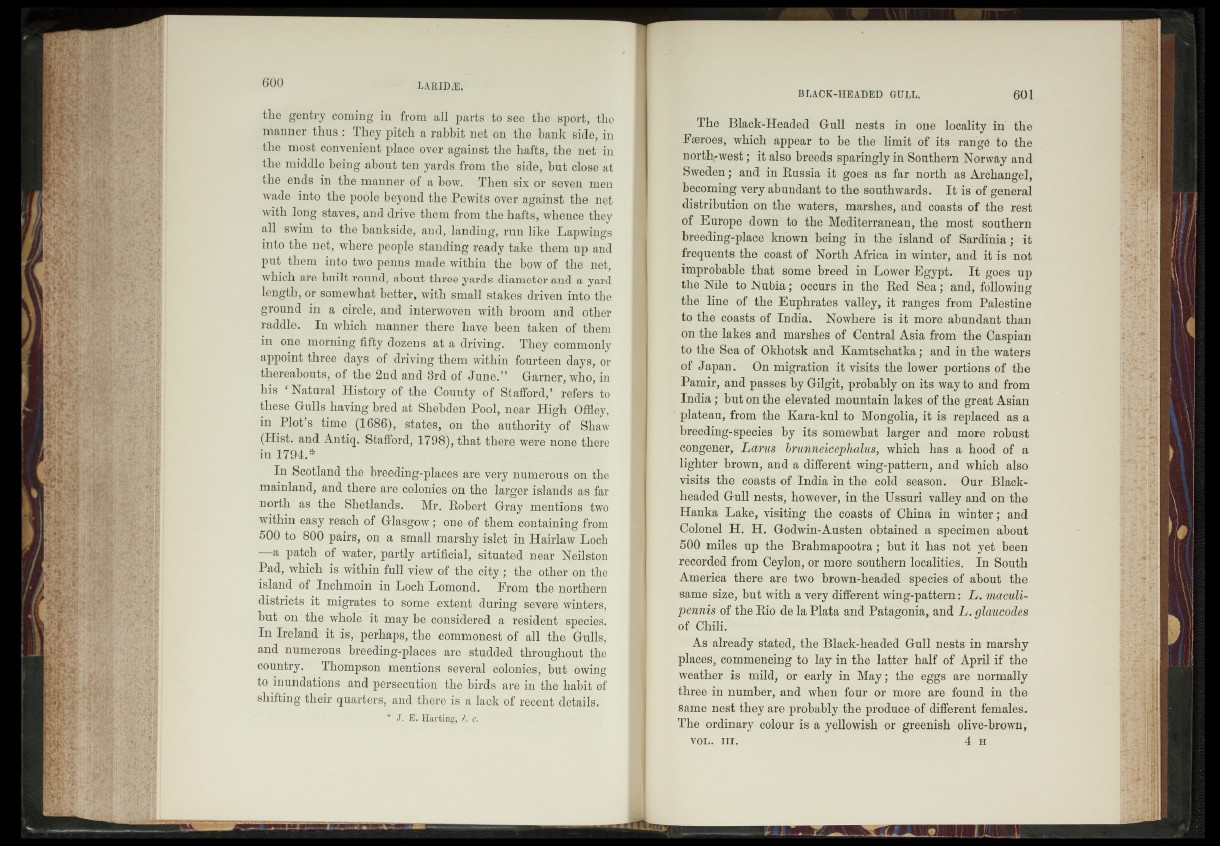
the gentry coming in fro®; all parts to see the sport, the
manner th u s: They pitch a rabbit net on the bank side, in
the most convenient place over against the Rafts, the net in
the. middle being-about ten yards from the ‘side, but close at
the ends in the manner-of a-b@w. „Then six or seven men
wade into the poole beyond the Pewits GVerjagainst the net
with long staves, and drive them from "the hafts, whence they
all swim to the bankside, and, landing, run like Lapwings
into the net, where people standing ready take them up and
put them into two penns made within the ~boW of the net,
which are built round, about three yards diameter and a yard
length, or somewhat better, with 'small stakes driven into the
ground in a circle, and interwoven with broom and ither
raddle. In which manner there have been taken, of-them
in one mofning fifty dozens at a driving. They''commonly
appoint three days of driving them within fourteen days, or
thereabouts, of the:2nd and 3rd of- Garner, who, in
his ‘Natural History of the W td ljfip k Stafford,’ refers $o
these Gulls having bred at gkehden Pool, near High Offley,;
in Plot’s time (1686), statesmen the authority of Shaw
(Hist, and Antiq. Stafford, 1798), that there were-none there
in 1794.*
In Scotland thé breeding-places are 'very numerous on the
mainland, and there are cjökMies on the larger islands as far
north as the Shetlands. Mr. Robert -Gray mentionsrtwo
within easy reach ofefrlasgow.; one of them containing from
500 to 800 pairs, on a small marshy Igjnt- in Hairlaw Loch
' a patch of water, partly artificial,. situated near Neils,tón
Pad, which is within full view ofifbe city ; the other om;tfe
island of Inchmoin in Loch Lomond. From the northern
districts it migrates’ to -SQ*^É extent ‘during severe, winters,
but on:.the whole it may be considered a rësidenfetspecies.
In Ireland it is, perhaps, the commonest of all thé Gulls,
and numerous breeding-places are studded throughout the
country. Thompson mentions several1 cblon-fesy but- ’owing
to inundations and' persecution the birds are in the habitnf
shifting their quarters, and there-is a lack of recent details.
* J. E.- Hartingj 'é-
* The Black-Headed Gull nests in one locality in the
Færoes, which appear to be the limit of its range to the
northewest ; it also breeds sparingly in Southern Norway and
Sweden ; and in Russia it goes as far north as Archangel,
becoming very abundant to the southwards. It is of general
distribution on the waters, marshes, and coasts of the rest
of Europe down to the Mediterranean, the. most southern
breeding-place known being island of Sardinia ; it
frequents the coast of North Africa in winter, and it is not
improbable that some breed in Lower Egypt. It goes up
the Nile to Nubia ; occurs in the Red Sea; and; following
the line of the Euphrates valley, it ranges from Palestine
to the coasts of India. Nowhere is it more abundant than
on the lakes and marshes of Central Asia from the Caspian
to the Sea of Okhotsk and Kamtschatka ; and in the waters
©# Japan. On migration it visits the lower portions of the
Pamir, and passes by Gilgit, probably on its way to and from
India ; but on the elevated mountain lakes of the great Asian
plateau, from the Kara-kul to Mongolia, it is replaced as a
breeding-species by its somewhat larger and more robust
congener, La/rus brunneicephalus, which has a hood of a
•lighter brown, and a different wing-pattern, and which also
visits the Coasts of India in the cold-^season. Our Black-
headed Gull nests, however, the Ussuri valley and on the
Hanka Lake, visiting the coasts of China hr winter ; and
Colonel H. H. Godwin-Austen obtained a specimen about
500 miles up the Brahmapootra ; but it has not yet been
recorded from Ceylon, or more southern localities. In South
America there are two brown-headed species of about the
same; size, but with a very different wing-pattern : L. maculi-
pennis of the Rio de la Plata and Patagonia, and L. glaucodes
of >CBili > *■
As already stated, the'Black-headed Gull nests in^marshy
places, commencing to lay in the latter half of April if the
weather is mild, or early in May ; the eggs are normally
Jhrëè in number, and when ^ four or more are found in the
same nest they are probably the produce of different females.
The ordinary colour is a yellowish or greenish olive-brown,
. VOL. III. 41 '